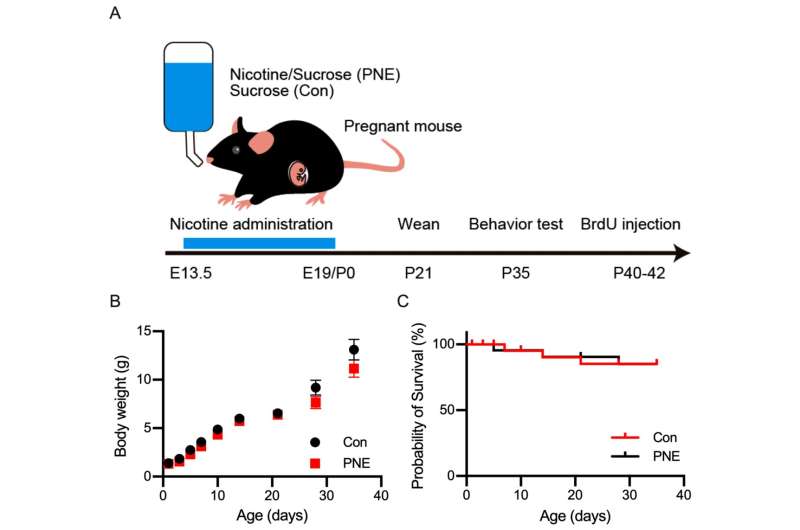This article has been reviewed according to Science X's editorial process and policies. Editors have highlighted the following attributes while ensuring the content's credibility:
fact-checked
trusted source
proofread
AI analysis predicts smoking during pregnancy may increase the risk of behavioral disorders in newborns

The fact that smoking is a risk factor for several diseases, including cancer, stroke, and diabetes, has been known for approximately half a century. However, over the past few decades, scientists have brought to light many of the detrimental effects of smoking during pregnancy, linking this habit to high infant mortality, failed delivery, and low body weight at birth.
In addition, recent studies suggest that prenatal nicotine exposure (PNE) may be related to neurodevelopmental disorders, such as attention-deficit/hyperactivity disorder (ADHD) and autism spectrum disorder (ASD).
For a long time now, scientists have used animal models (like rodents) to understand how PNE leads to neurodevelopmental disorders. By carefully analyzing the behavior of rodents, they can infer whether PNE is causing neurological changes and the brain regions affected by it; this can later be confirmed through histological analyses.
Unfortunately, thus far, studies on behavioral changes induced by PNE in mice have shown varied results, some of which are contradictory. Although there could be multiple reasons behind these discrepancies, human error and bias are prime suspects. In general, the assessment of complex animal behaviors, especially social interactions, relies on the efforts of human observers, which introduces a baseline level of subjectivity that is hard to dispel.
But what if we can leverage artificial intelligence (AI) to produce more accurate and unbiased results from observations of PNE mice behavior?
In a study published in Cells, researchers from the Department of Molecular and Cellular Physiology at the Shinshu University School of Medicine, including graduate student Mengyun Zhou, Assistant Professor Takuma Mori, and Professor Katsuhiko Tabuchi, developed and trained a deep learning-based system to automatically analyze footage from behavioral experiments on mice.
They used this tool to explore the behavioral changes induced by PNE in mice without observer biases, seeking to shed light on the link between nicotine and neurodevelopmental disorders.
The proposed AI-based framework relied on a combination of two well-established open-source toolkits, namely DeepLabCut and Simple Behavioral Analysis (SimBA). "AI tools can label the body parts of animals in markerless video footage and precisely estimate their poses using supervised machine learning," explains Prof. Tabuchi.
"Since animal behaviors are defined as a specific arrangement of body parts over a short period of time, deep-learning toolkits like SimBA can use the pose estimations obtained with DeepLabCut to classify different types of animal behaviors."
After reaching an optimal training protocol for their framework using manually labeled data, the researchers conducted several experiments using PNE and control mice, looking for indicators of ADHD- and ASD-like behaviors.
First, they carried out cliff avoidance reaction tests, which are used to test impulsivity. In these tests, they placed the subject mouse on top of a slightly elevated platform and took note—both manually and with the AI system—of how long the mouse waited before jumping down the platform. The test results suggested that PNE mice are more impulsive, a behavioral feature of ADHD in humans.
They also tested the working memory of mice using a Y-shaped maze and counted the number of times each mouse spontaneously switched from one arm of the maze to another.
"We observed a decrease in the spontaneous alteration in PNE mice, suggesting that their working memory was altered, which is another behavioral feature of ADHD," comments Mengyun Zhou. "These results suggest prenatal exposure to nicotine may cause ADHD in mice, which is consistent with clinical reports in humans."
Finally, the researchers conducted open-field and social-interaction experiments, which represented the main challenge for their AI-based system. In these experiments, the researchers observed either one or two mice behaving freely in a large enclosure and looked for indicators of anxiety and social behaviors, such as grooming and following. Interestingly, PNE mice exhibited social behavioral deficits and increased anxiety, which are features of ASD.
Subsequent histological analysis of hippocampal brain tissue confirmed decreased neurogenesis, a hallmark of ASD. Thus, it appears that smoking may not only increase the risk of ADHD but also ASD.
Worth noting, the results obtained using the AI-based system were highly reliable. Prof. Tabuchi says, "We validated the accuracy of our behavioral analysis framework by drawing a careful comparison between the results generated by the model and behavior assessments made by multiple human annotators, which is considered the gold standard." These analyses cement the potential of the proposed approach and showcase its capabilities for many types of behavioral studies.
With any luck, further efforts will pave the way to a solid understanding of mechanisms behind neurodevelopmental disorders like ASD and ADHD, ultimately leading to better diagnostic tools and therapeutic methods.
More information: Mengyun Zhou et al, Deep-Learning-Based Analysis Reveals a Social Behavior Deficit in Mice Exposed Prenatally to Nicotine, Cells (2024). DOI: 10.3390/cells13030275




















